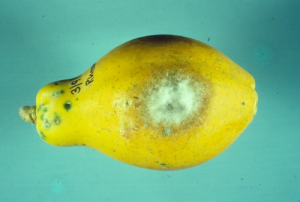Back to > Major Fruits | Minor Fruits | Underutilized Fruits
![]()
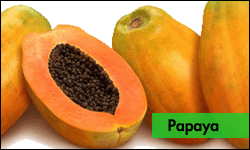 |
||
|
|
||
For more plant health information, including diagnostic resources, best-practice pest management advice and plant clinic data analysis for targeted crop protection, visit CABI’s Plantwise Knowledge Bank.
Pest & Disease Management:
Diseases of Papaya:
Papaya are very susceptible to diseases caused by many microorganisms especially fungi. Fungi can infect the fruit at the following stages: pre harvest, during harvesting, subsequent handling and marketing operations.
Besides, the infection is also greatly affected by the physiological conditions of the fruit, the temperature and the storage environment.
Bacterial Diseases
Bacterial canker: Erwinia sp.
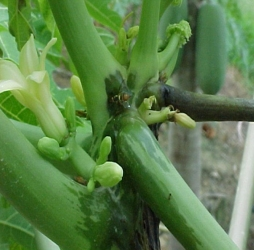 Water-soaked areas on base of leaf stalks and crown of papaya infected with Erwinia papayae. |
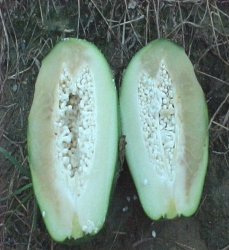 Fruits infected by Erwinia papayae, flesh with water-soaked areas |
Bacterial leaf spot: Pseudomonas carica-papayae Robbs.
Bacterial wilt: Pseudomonas solanacearum E. F. Smith
Black rot: Erwinia cypripedii (Hori) Bergey et al (=Pectobacterium cypripedii (Hori) Brenner et al.)
Bunchy top: Unknown bacterium
Erwinia decline: Erwinia sp.
Erwinia mushy canker: Erwinia sp.
Internal yellowing: Enterobacter cloacae (Jordan) Hormaeche & Edwards
Purple stain: Erwinia herbicola Löehnis Dye
Fungal Diseases
Alternaria fruit spot: Alternaria alternata (Fr.:Fr.) Keissl.
Angular leaf spot: Leveillula taurica (Lév.) G. Arnaud .
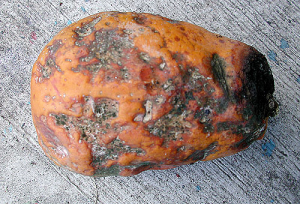 Black spot: Asperisporium caricae (Speg.) Maubl. |
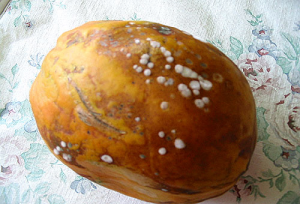 Black spot: Asperisporium caricae (Speg.) Maubl. |
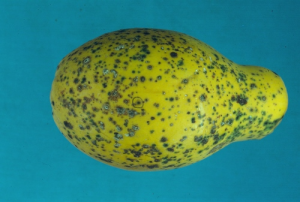 Cercospora papayae Hansf |
Anthracnose: Colletotrichum gloeosporioides (Penz.) Penz. & Sacc. in Penz): Mainly attacks the maturing fruit, with mature fruit being more susceptible.
Symptoms:
- small water-soaked spots that enlarge
- turn brown or black and become darker
- the fungus grow into the fruit tissue, ruining it for consumption
Effects: the pathogen grows into the fruit, resulting in softening of the fruit and on off flavor.
- causes small round, dark areas on ripe fruit which later enlarge into sunken lesions
- fruit will rot
Control:
- practice a prophylactic program.
Blossom spot: Choanephora cucurbitarum (Berk. & Ravenel) Thaxt.
Brown spot: Corynespora cassicola (Berk. & M. A. Curtis) C. T. Wei (=Cercospora melonis Cooke; = C. vignicola E. Kawamura; =Helminthosporium cassiicola Berk. & M. A. Curtis; =H. vignae Olive in Olive, Bain, & Lefebvre); = H. vignicola (E. Kawamura) Olive
Chocolate spot: Colletotrichum gloeosporioides (Penz.) Penz. & Sacc. in Penz.
Collar rot: Cylindrocladium crotalariae (C. A. Loos) D. K. Bell & Sobers (teleomorph: Calonectria crotalariae (C. A. Loos) D. K. Bell & Sobers)
Damping off: Colletotrichum gloeosporioides (Penz.) Penz. & Sacc. In Penz., Phytophthora palmivora (E. J. Butler) E. J. Butler, Phytophthora nicotianae Breda de Haan var. parasitica, (Dastur) G. M. Waterhouse (=Phytophthora parasitica Dastur), Pythium aphanidermatum (Edson) Fitzp., Pythium debaryanum Auct. non R. Hesse, Pythium ultimum Trow, Pythium sp., Rhizoctonia solani Kühn, (teleomorph: Thanatephorus cucumeris (A. B. Frank) Donk)
Foot rot: Pythium aphanidermatum (Edson) Fitzp., Pythium ultimum Trow
Fruit rot: Monilia sp.
Fruit spot: Cercospora mamaonis Viégas & Chupp
Fusarium fruit rot: Fusarium solani (Mart.) Sacc., Fusarium spp.
Guignardia spot: Guignardia sp.
Greasy spot: Corynespora cassiicola. (Berk. & M. A. Curtis) C. T. Wei (=Cercospora melonis Cooke; = C. vignicola E. Kawamura; =Helminthosporium cassiicola Berk. & M. A. Curtis; =H. vignae Olive in Olive, Bain, & Lefebvre); = H. vignicola (E. Kawamura) Olive
Internal blight: Cladosporium sp., Fusarium sp., Penicillium sp.
Lasiodiplodia fruit rot: Lasiodiplodia theobromae (Pat.) Griffon & Maubl. (=Botryodiplodia theobromae Pat.; =B. gossypii Ellis. & Barth.; =Diplodia theobromae (Pat.) W. Nowell; =D. gossypina Cooke; =D. natalensis Pole-Evans; =Lasiodiplodia triflorae Higgins)
Leaf spot: Alternaria sp., Asperisporium caricae (Speg.) Maubl., Cercospora mamaonis Viégas & Chupp, Cercospora papayae Hansf., Choanephora cucurbitarum (Berk. & Ravenel) Thaxt., Curvularia carica-papayae Srivastava and Bilgrami
Gloeosporium sp., Punithalingam (teleomorph: Mycosphaerella caricae Syd. & P. Syd.), Phyllosticta sp.
Dry rot: Phoma caricae-papayae (Tarr) Punithalingam (=Ascochyta carica Pat. and A. caricae-papayae Tarr), (teleomorph: Mycosphaerella caricae Syd. & P. Syd.):
Petiole spot: Didymella sp.
Phytophthora blight: Phytophthora palmivora (E. J. Butler) E. J. Butler
Phytophthora nicotianae Breda de Haan var. parasitica, (Dastur) G. M. Waterhouse (=Phytophthora parasitica Dastur)
Phytophthora fruit rot: Phytophthora capsici Leonian, Phytophthora nicotianae Breda de Haan var. parasitic, (Dastur) G. M. Waterhouse (=Phytophthora parasitica Dastur)
Phytophthora palmivora (E. J. Butler) E. J. Butler
Rhizopus soft rot: Vuill. (=R. nigricans Ehrenb.)
Root rot [ Phytophthora palmivora (E. J. Butler) E. J. Butler]:
Symptoms:
- rapid browning and wilting of the plants, followed by total collapse within days.
- young leaves wilt and matured leaves turn yellow and drop
- causing root rot, collar rot and fruit rot and also has a foul odor
- if not control, the leaves drop and plant will die.
Control:
- spray with metalaxyl
Sclerotium blight: Sclerotium rolfsii Sacc., (teleomorph: Athelia rolfsii (Curzi) Tu & Kimbrough)
Seedling blight: Colletotrichum gloeosporioides (Penz.) Penz. & Sacc. in Penz.
Stem-end rot: Alternaria alternata (Fr.:Fr.) Keissl., Colletotrichum gloeosporioides (Penz.) Penz. & Sacc. In Penz., Fusarium sp., Lasiodiplodia theobromae (Pat.) Griffon & Maubl., (=Botryodiplodia theobromae Pat. =B. gossypii Ellis. & Barth.; =Diplodia theobromae (Pat.)W. Nowell; =D. gossypina Cooke; =D. natalensis Pole-Evans; =Lasiodiplodia triflorae Higgins), Phoma caricae-papayae (Tarr) Punithalingam (=Ascochyta carica Pat. and A. caricae-papayae Tarr)
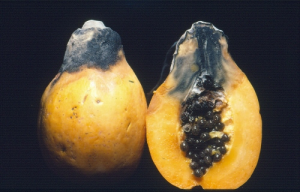 Mycosphaerella caricae Syd. & P. Syd. |
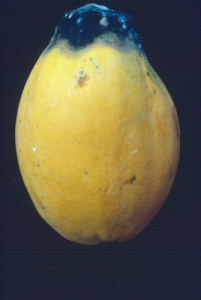 Stem end rot (C. gloeosporioides) |
Rhizopus stolonifer (Ehrenb.:Fr.) Vuill. (=R. nigricans Ehrenb.)
Stemphylium fruit spot: Stemphylium lycopersici (Enjoji) W. Yamamoto (=Thyrospora lycopersici Enjoji; =S. floridanum Hannon & G. F. Weber)
Stem rot: Fusarium solani (Mart.) Sacc. (teleomorph: Nectria haematococca Berk. & Broome), Fusarium sp., Phytophthora palmivora (E. J. Butler) E. J. Butler, Pythium aphanidermatum (Edson) Fitzp., Pythium ultimum Trow
Target spot: Phyllosticta caricae-papayae Allesch.
Verticillium wilt: Verticillium dahliae Kleb.
 Wet fruit rot: Phomopsis sp. |
Powdery Mildew (Oidium caricae, Erysiphe cichoracearum De Candolle, Erysiphe sp., Oidium caricae F. Noack, O. indica Kamat, Ovulariopsis papayae van der Bilz, Sphaerotheca fuliginea (Schlecht.) Poll., S. humuli (D.C.) Burr.: Primarily a disease of the leaves inFlorida.
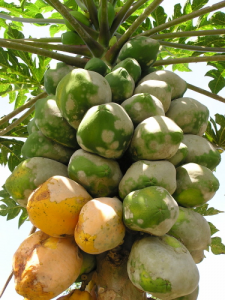 Powdery mildew: Oidium caricae F. Noack |
Symptoms:
- a superficial white fungus growth on leaf surface
- it leads to small, light yellow spots on the lower surfaces of leaves
As the spots enlarge, a white powdery growth (fungal hyphae and spores) appears
Effect: some leaf drop can occur if powdery mildew is not a severe problem
Control: removing infested leaves and removing them from near the plants
Phytopthora Blight (Phytophthora spp.): A fungus disease development enhance by cool, wet environmental condition with high soil moisture.
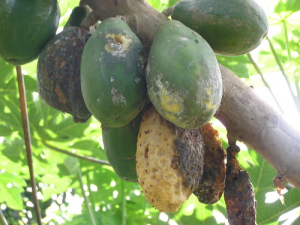 Phytophthora blight: Phytophthora palmivora (E. J. Butler) E. J. Butler |
Symptoms:
- occurs in very young plants, damping off, root rot, stem rot and fruit rot
Damping Rot: spots on the stems of established plants begin as water soaked lesions, at fruit and branch scars
Fruit Rot: water soaked spots are evidence that the fungus is present. Become covered with a characteristic mass of whitish fungal growth
Effects:
- decrease plant vigor and may result in plant death
- Fruit eventually shrive and fall to the ground
Corynespora Leaf Spot (Corynespora cassiicola): A disease of the leaves and begins as small, yellow areas which expend into larger (0.2 to 0.4 inches circular brown spots).
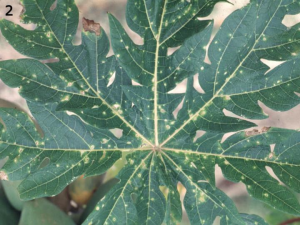 Corynespora Leaf Spot (Corynespora cassiicola) |
Insect Pest of Papaya:
Papaya Fruit Fly (Toxotrypana curvicauda): Lays eggs through the papaya fruit peel into the fruit cavity where the larvae feed. Eventually emerge from the ruined fruit.
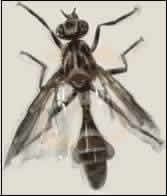 Papay Fruit Fry (Toxotrypana curvicauda) |
Symptoms: may show yellow areas and drop from the tree prematurely.
Control:
- place a paper bag over individual fruit when they are small.
- leave the bag on until harvesting.
Oriental Fruit flies (Bactrocera spp): attacks ripe fruit causing fruit damage.
Control: Harvesting done before fruit turn yellow spray with dimethoate 0.1% or acephate
Mechanical Control
Mechanical methods of controlling the oriental fruit fly include the use of protective coverings on the fruit and the destruction of adults by use of traps. Shrubs within 100 yards of larval hosts may be used advantageously in placing traps. The use of protective coverings is more effective and costly than the use of traps.
Cultural Control
There are three principal cultural methods that may be used for controlling this pest. These methods are: 1) field sanitation, 2) trap crops and 3)resistant varieties.
Of utmost importance and effectiveness is field sanitation. This practice reduces re-infestation pressure. All unmarketable and infested fruits must be destroyed. Crops should be plowed and disked under as soon as harvest has been completed.
Pre-harvest control measures such as field sanitation could enhance the quality of marketable fruit by allowing the use of less damaging schedules of post harvest quarantine treatments. For example, vapor heat, dry heat, hot water double dip or a combination of these treatments) could be applied at lower kill temperatures or shorter treatment durations.
Biological Control
Diachasmimorpha longicaudata or Opius longicaudatus var. malaiaensis (Fullaway), O. vandenboschi (Fullaway), and O. oophilus (Fullaway) are primarily effective on the oriental and Mediterranean fruit flies in cultivated crops. O. longicaudatus is a parasite of the second and third instar fruit fly larvae; O. vandenboschi is a parasite of the first instar fruit larvae; and O. oophilus is an egg-larval parasite. O. longicaudatus females are commonly seen on over-ripe fruits on the ground and ripe fruits on the trees where O. oophilus females are primarily associated with fruits on the trees.
The pathogen, Nosema tephritidae a microspordian ingested by mouth, also attacks this fly. Diseased larvae and pupae appear normal externally. Symptoms are not easily detected until the adult stage when infected individuals are sluggish, have dropping wings and distended abdomen, and poor to no flying ability. Death primarily occurs during late pupation. This pathogen also affects the melon fly, Bactrocera cucurbitae, and the Mediterranean fruit fly, Ceratitis capitata.
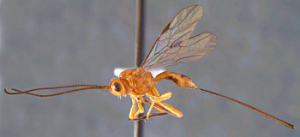 Diachasmimorpha longicaudata |
Chemical Control:
The chemicals used for oriental fruit fly control have been used as 1) toxicants in baits and 2) sprays.
Insecticide bait sprays are applied either to the crops to be protected, to the plants with which the adults are closely associated, or to both.
Proteinaceous liquid attractants in insecticide sprays is a recommended method of controlling adult Oriental fruit fly populations in the vicinity of crops. The bait insecticide sprays are applied to broad leaf plants that serve as refugia for Oriental fruit fly adults. Baits serve to encourage the adults (especially females) to feed on the spray residue and can provide good rates of kill. To be effective, bait-insecticide sprays must be used in combination with good sanitation practices. These practices include destruction of unmarketable fruit on every harvest date, and destruction of crop residues immediately after economic harvest has been completed.
Red Spider Mites (Tetrarynchus spp):
Symptoms:
- induce premature leaf drop, reduce tree vigour and cause external blemishes on the fruits
Control:
- spray with dicofol or propagite 0.1% a.i
Thrips (Thrips parvispinus)
Symptoms:
- the insect attack shoot, young leaves and flower bud
- causes spots and abnormal fruits size
Control:
- spray with dimethoate (0.1% a.i) or malathion 0.1% a.i
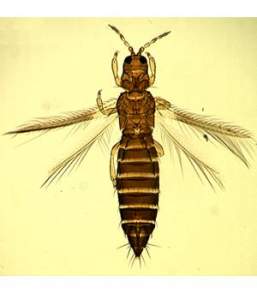 Red Spider Mites Thrips (Thrips parvispinus) |
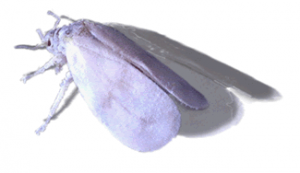 White fly(Trialeuroides variabilis) |
Papaya Webworm (Homolapalpia dalera): These are sometimes referred to as the fruit cluster worm, but is commonly called papaya webworm. It develops under a web between and around fruits and along stems of plants. Usually found in or on or near the stem amongst the flower and fruit.The webworm causes injury to fruit and stem, providing an entrance for the fungus disease, anthracnose. It is the main pest of the developing fruit peel and papaya stem.
Control:
- hand removal (manually)
- hosing off the plant with a strong jet of water
- Permethrin (Pounce 3.2 EC used at 8 oz/acre) is recommended.
- use of malathion and/or Bacillus thuringiensis for other insects may reduce or aid in the control of webworms.
Papaya Whitefly (Trialeuroides variabilis): pest of the leaves and causes leaves to drop and reduction in fruit production
Controls:
- removing infested leaves
- applying appropriate pest control products
Two-Spotted Mite (Tetranychus urticae): Major pest of papaya leaves and causes defoliation and early leaf drop.
Symptoms:
- browning of the leaf surface, eventually upper leaf surface
- skeletonizing of the leaf
Control:
- Treatment with sulphur or kelthane (0.1%), (controls the mites population)
- spraying with diluted manipueira (a liquid extract from cassava root) in water 1:3, 3 times weekly intervals gave 100% control.
Bunchy and malformed top: (interaction between Thrips parvispinus and Cladosporium oxysporum Berk)
Symptoms:
- causes spots on young leaves and brown spots on old leaves
- the affected leaves curles and distorted
- in severe infestation the fruit become distorted and small.
Controls:
- spray with benomyl 0.1% a.i to control C.oxysporum
- spray with carbaryl, thrips. dimethoate or permethrin (0.1% a.i) to control
MISCELLANEOUS DISEASES & DISORDERS:
Algal leaf spot: Cephaleuros virescens Kunze , Hivum Haamir Dieback and fruit skips
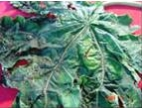 Algal leaf spot |
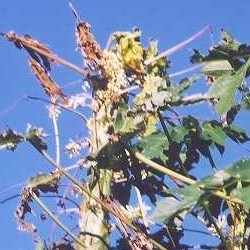 Nivum Haamir dieback (Candidatus Phytoplasma australiense) |
Bumpy fruit: This is widespread in many countries, including thePhilippines,Thailand,Korea,Malaysia andJapan. It is more common in volcanic soils, or in soils derived from igneous rocks. It is not often found in soils derived from sedimentary rocks such as sandstone.
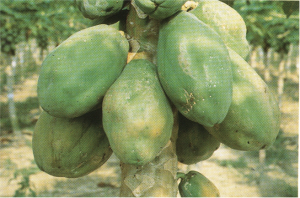 Bumpy fruit (Boron deficiency) |
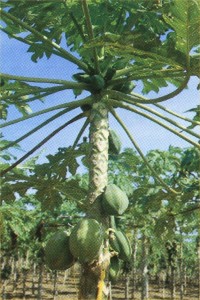 Fruit Skips of Eksotika |
NEMATODES, PARASITIC
Nematodes: (Meloidoiygne incognita, Rotylenchulus reniformis), Meloidoiygne incognita
Characteristic: small, microscopic, worm like organisms
Feed on papaya plant roots
Causes:
- Plants to decline vigor
- making more plants more susceptible to toppling over because of the loss roots
Precaution/ Controls:
- should be planted in areas with clean soils
- avoiding areas of the landscape with known nematode problems.
Reniform nematode: Rotylenchulus reniformis Linford and Oliveira, R. parvus (Williams) Sher.
Root-knot nematode: Meloidogyne incognita (Kofoid & White)
Chitwood, M. javanica (Treub) Chitwood, M. arenaria (Neal) Chitwood, M. hapla Chitwood
PHYTOPLASMAL DISEASES
Dieback
Phytoplasma
Yellow crinkle
Phytoplasma
VIRUS & VIROID DISEASES
- Apical necrosis
- Papaya apical necrosis rhabdovirus
- Droopy necrosis
- Papaya droopy necrosis rhabdovirus
- Feather leaf
- Unknown virus
- Leaf curl
- Virus suspected
- Mosaic
- Papaya mosaic potexvirus
Papaya Ringspot Virus (PRV): Most important disease of papaya (Potyvirus is the most important disease of the crop in Florida) carried by a vector Aphis gossypii and Aphis craccivora Koch.
Symptoms:
- Earliest sign: a yellow mottling of leaves and vein clearing of younger leaves.
- followed by a prominent yellow mottling of the leaves
- As the disease progress, the lobes of the leaves become distorted and leaf size is greatly reduce
- the leaves that infected will shown the sign of blistered, roughened or narrow with blades curving upwards from the midrib
- Dark green streaks may develop on petioles and the main stem because of this disease
- The symptom consist of dark circles or C-shaped marking fruit peel, (the colour of this marking are darker green than the natural colour)
Effects:
- Viral infection impacts growth
- Reduction in fruit set and quality
- Therefore, the flavor of the fruit also affected
Control:
- All trees that was infected by this virus should be removed so as not to be a source of infection for new plants
- Recommendation control: Replanting the papaya plants every 18-24 months (physical separation)
- Aphids can be controlled or malathion. by spraying by carbaryl or dimethoate.
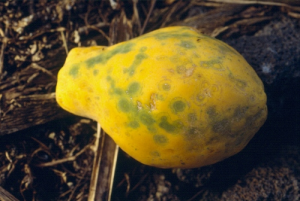 Papaya Ringspot Virus (PRV) on fruit and leaves |
- Spotted wilt
- Tomato spotted wilt tospovirus
- Terminal necrosis and wilt
- Tobacco ringspot nepovirus
Papaya Apical Necrosis (New virus found inFlorida)
Symptoms:
- A drooping and downward cuppy of the leaves
- reduced leaf size
- browning of the leaf margins
Leaf Spot (Asperiosporium caricae): Lesions produce by the fungus. The disease is the most prevalent in the fall and winter
Symptoms:
- Lesions appear as pale spots on the underside of mature leaves
- The spots enlarge, developing a pale or yellowish colour, becoming obvious on the upper leaf surface
Reference:
- Chong, S.T., R. Prabhakaran and H.K. Lee. ISHS Acta Horticulturae 787: International Workshop on Tropical and Subtropical Fruits.
- Lamberts, M. and J.H. Crane. 1990. Tropical fruits. p. 337-355. In: J. Janick and J.E. Simon (eds.), Advances in new crops. Timber Press,Portland,OR.
- Morton, J. 1987. Papaya. p. 336–346. In: Fruits of warm climates. Julia F. Morton,Miami,FL.

